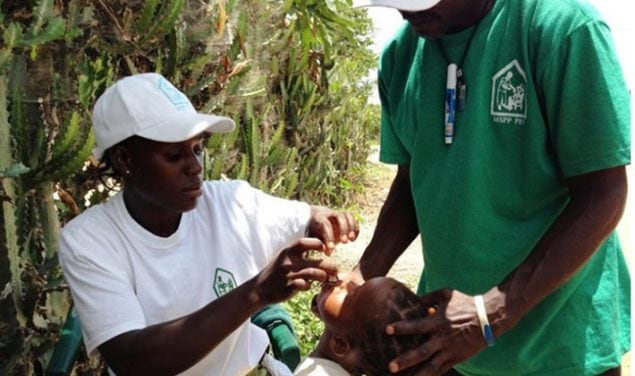Why CDC is Involved with Global Cholera
Updated March 22, 2022
Health Costs: Cholera Can Lead to Serious Illness and Death

A police officer receives oral cholera vaccine (OCV) during an OCV campaign in Democratic Republic of the Congo, 2021. Credit: WHO/Kabambi
Cholera is one of the most rapidly fatal infectious diseases. If left untreated, healthy adults and children can die within hours. Each year, there are an estimated 1.3 to 4 million cholera cases and 21,000 to 143,000 deathsexternal icon. Persons living in places with unsafe drinking water, poor sanitation, and inadequate hygiene are at the highest risk for cholera. The risk of a cholera outbreak increases during humanitarian crises, natural disasters, and population migration when people are likely to experience limited access to safe water, poor sanitation conditions, and overcrowding – all risk factors for cholera. About 1.3 billion people are at risk of cholera in countries where local transmission occurs. However, the true burden of cholera may be higher because cases are largely underreported.
Cholera Vaccines Protect Communities When Combined With Other Standard Prevention Measures
Oral cholera vaccines (OCV) can be used to help prevent and control cholera, in addition to other standard prevention measures including improved access to clean water, adequate sanitation, and good hygiene practices.
The World Health Organization (WHO) recommendsexternal icon that countries use cholera vaccines in areas where local transmission of cholera occurs, during humanitarian crises with a high risk of cholera, and during cholera outbreaks. There are currently three OCV approved by the World Health Organization as safe and effective for use. Two doses of OCV provide protection against cholera for at least 3 years, preventing about 2 of 3 cholera infections.
CDC Works to Address Barriers to Vaccine Access

A child receives oral cholera vaccine in Haiti, 2010.
In response to the Haiti cholera outbreak in 2010 that caused nearly 10,000 deaths, WHO and partners established a global OCV stockpile in 2013 to help respond and save lives during public health emergencies. This stockpile has significantly increased the emergency use of OCV in cholera-affected countries to help control outbreaks or prevent potential outbreaks during humanitarian crises. During 2013–2018, 24 countries conducted 104 emergency or preventive OCV campaignsexternal icon, administering over 36 million doses. With the recommendation to use OCV in endemic settings and to control cholera outbreaksexternal icon, the potential demand for OCV will likely increase beyond the stockpile and current manufacturer production capacity. CDC is working with the Global Task Force on Cholera Control (GTFCC) to help address the OCV demand and supply issues.
Actions: CDC Works to Support Cholera Vaccine Activities Worldwide
CDC works with partners and countries to implement and improve the quality of OCV campaigns.